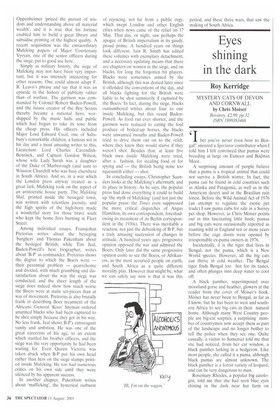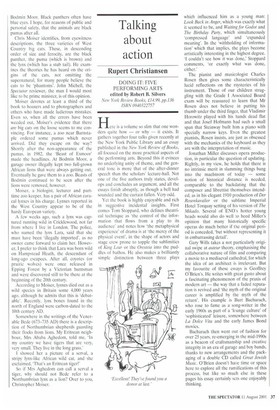Eyes shining in the dark
Roy Kerridge
MYSTERY CATS OF DEVON AND CORNWALL by Chris Moiser
Bossiney, £2.99, pp.32 ISBN 1899383468
Ibet you've never even been to Bengal!' sneered a Spectator contributor when I told him I felt convinced that pumas were breeding at large on Exmoor and Bodmin Moor.
A surprising amount of people believe that a puma is a tropical animal that could not survive a British winter. In fact, the puma can be found in cold countries such as Alaska and Patagonia, as well as in the American desert and in the Brazilian rain forest. Before the Wild Animal Act of 1976 (an attempt to regulate the exotic pet trade) I saw puma cubs for sale in a Surrey pet shop. However, as Chris Moiser points out in this fascinating little book, pumas and big cats were occasionally reported as roaming wild in England ten or more years before the cage doors were opened by irresponsible ex-puma owners in 1976.
Incidentally, it is the tiger that lives in Bengal, not the puma, which is a New World species. However, all the big cats can thrive in cold weather. The Bengal tiger finds Bengal too hot for its tastes, and often plunges into deep water to cool off.
A black panther, superimposed over moorland gorse and heather, glowers at the reader from the cover of Moiser's book. Moiser has never been to Bengal, as far as I know, but he has been to west and southern Africa to see big cats in their natural home. Although many West Country people are big-cat sceptics, a surprising number of countrymen now accept them as part of the landscape and no longer bother to tell the police when they see one. Quite casually, a visitor to Somerset told me that she had noticed, from her car window, a black panther lurking in a hedgerow. Like most people, she called it a puma, although black pumas are almost unknown. The black panther is a forest variety of leopard, and can be very dangerous to man.
Rosemary Rhodes, a popular big catologist, told me that she had seen blue eyes shining in the dark near her farm on Bodmin Moor. Black panthers often have blue eyes. I hope, for reasons of public and personal safety, that the animals are black pumas after all.
Chris Moiser identifies, from eyewitness descriptions, the three varieties of West Country big cats. These, in descending order of size and ferocity, are the black panther, the puma (which is brown) and the lynx (which has a stub tail). He examines the theories he has heard on the origins of the cats, not omitting the supernatural, for many people believe the cats to be 'phantoms'. John Michell, the Spectator reviewer, the man I would most like to be prime minister, is of this opinion.
Moiser devotes at least a third of the book to hoaxers and to photographers and others who have made ludicrous mistakes. Even so, when all the errors have been weeded out, Moiser's evidence that there are big cats on the loose seems to me convincing. For instance, a zoo near Barnstaple ordered some pumas which never arrived. Did they escape on the way? Shortly after the non-appearance of the pumas, in 1982, the 'Beast of Exmoor' made the headlines. At Bodmin Moor, a garage owner illegally kept two full-grown African lions that were always getting out. Eventually he gave them to a zoo. Beasts of Bodmin continued to be seen after the lions were removed, however.
Moiser, a biologist, lecturer and parttime zoo keeper, has a pair of African caracal lynxes in his charge. Lynxes reported in the West Country appear to be of the hardy European variety.
A few weeks ago, such a lynx was captured running wild in Cricklewood, not far from where I live in London. The police, who named the lynx Lara, said that she must have been 'illegally imported', as no owner came forward to claim her. However, 1 prefer to think that Lara was born wild on Hampstead Heath, the descendant of long-ago escapees. After all, coyotes (or prairie wolves) were once released in Epping Forest by a Victorian huntsman and were discovered still to be there at the beginning of the 20th century.
According to Moiser, lynxes died out as a wild species in Britain some 4,000 years ago, although he admits that this is 'debatable'. Recently, lynx bones found in the north of England were carbon-dated to the 10th century AD.
Somewhere in the writings of the Venerable Bede (673-735 AD) there is a description of Northumbrian shepherds guarding their flocks from lions. My Eritrean neighbour, Mrs Ababa Aghedom, told me, 'In my country we have tigers that are very, very small. They live in the long grass.'
I showed her a picture of a serval, a stripy lynx-like African wild cat, and she exclaimed, 'That's an Eritrean tiger!'
So if Mrs Aghedom can call a serval a tiger, why should not Bede refer to a Northumbrian lynx as a lion? Over to you, Christopher Moiser.



























































 Previous page
Previous page